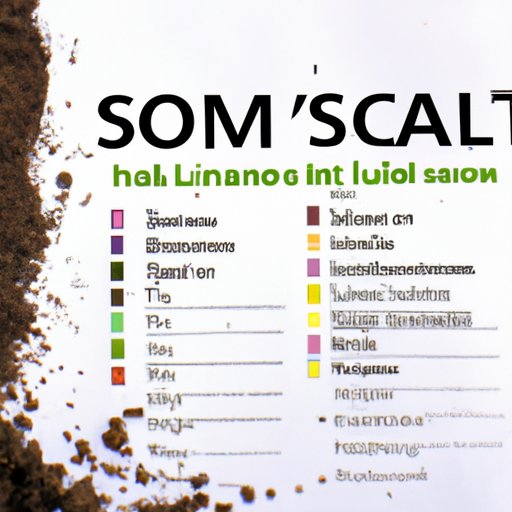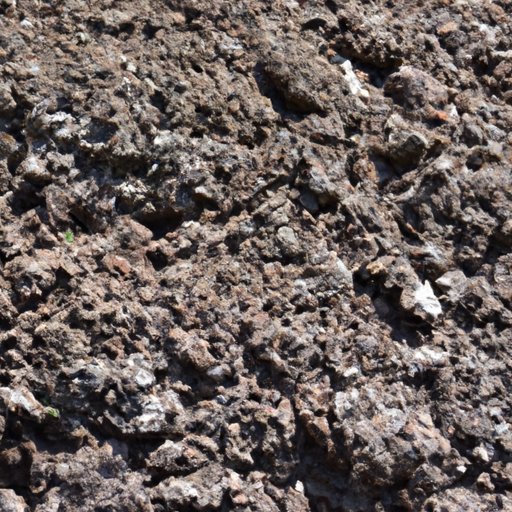Introduction
Gardening and agriculture are essential elements that support human life, and have been carried out for thousands of years. However, one of the essential aspects of a successful garden or farm is the soil in which the plants grow. Different types of soils are suitable for different purposes, but one stands out: loam soil. In this article, we will explore what is loam, the benefits it offers for gardening and agriculture, how to identify it, and other related topics.
Defining Loam Soil: Texture and Composition
Loam soil is a type of soil that is characterized by its balanced content of sand, silt, and clay. It has a rich, dark color, and is very friable, which means it crumbles easily when held in the hand. Loam soil has a pH of about 6.5-7, which is neutral, making it suitable for growing a wide range of plants. It also contains a lot of organic matter, which makes it a fertile soil.
Loam soil is formed through the gradual breakdown of rocks by weathering or erosion. It can also be formed through human-made activities such as composting or mixing different types of soil. It is commonly found in forests, grasslands, and meadows. However, it can also be found in gardens, farms, and parks where it has been introduced through human intervention.
Benefits of Loam Soil for Gardening and Agriculture
Loam soil is considered one of the most beneficial types of soil for gardening and agriculture. Some of the benefits include:
Nutrient Retention and Availability
Loam soil contains a lot of organic matter that provides the necessary nutrients for plant growth. The presence of both clay and sand particles also allows for the retention of essential minerals and nutrients needed by plants to thrive.
Water Drainage and Retention
Loam soil has excellent drainage properties, which makes it suitable for growing plants that require a well-drained soil. On the other hand, it can also retain adequate amounts of water, making it suitable for plants that require a moist soil.
How Loam Soil Supports Healthy Plant Growth
Loam soil has an excellent structure that allows for optimum root growth. Its ability to retain moisture and nutrients also supports strong plant growth and development. This combination of characteristics makes it ideal for growing plants that require healthy and robust root systems such as vegetables, fruits, and flowers.
Benefits for Sustainable Agriculture Practices
Loam soil is an essential component of sustainable agriculture practices such as organic and regenerative farming. It contributes to overall ecosystem health and supports biodiversity by providing a conducive environment for various soil microbes. It also promotes soil retention, which reduces soil erosion and water pollution.

Identifying Loam Soil: A Comprehensive Guide for Gardeners
Identifying loam soil requires knowledge of its characteristics and properties. Here are a few guidelines to help identify loam soil:
Soil Testing Techniques
Soil testing is an essential aspect of identifying soil types. One common method is the jar test, which involves filling a jar with soil and water and shaking it to determine the percentage of sand, silt, and clay. Additionally, the pH of the soil can be determined using a pH meter or test kit.
Characteristics and Properties to Look For
Loam soil has a rich, dark color and is very friable when held in the hand. It also has a balanced content of sand, silt, and clay particles, which can be easily determined by the jar test. Loam soil has an overall pH of about 6.5-7 and contains a lot of organic matter, which is visible through its dark color.
Examples of Plants that Thrive in Loam Soil
Loam soil is suitable for growing a wide range of plants, including vegetables, fruits, and flowers. Some examples of plants that thrive in loam soil include tomatoes, lettuce, peppers, strawberries, and roses.
The Role of Loam Soil in Sustainable Agriculture: An Environmental Perspective
The use of loam soil in sustainable agriculture practices contributes to overall environmental health. Here are some ways loam soil can be used in sustainable agriculture:
Sustainability Practices that can be Used with Loam Soil
Using loam soil in sustainable agriculture practices involves embracing techniques that reduce soil erosion, promote biodiversity, and prevent soil degradation. These practices may include crop rotation, agroforestry, using cover crops, and reducing tillage.
How Loam Soil Contributes to Overall Ecosystem Health
Loam soil provides a conducive environment for various microorganisms such as bacteria and fungi that decompose organic matter and convert it to nutrients that plants can use. Additionally, loam soil promotes water infiltration and storage, which is essential for supporting a healthy water cycle.
Benefits of Using Loam Soil in Organic and Regenerative Farming Practices
Loam soil is an essential component of organic and regenerative farming practices that focus on soil conservation and promoting biodiversity. This soil type contributes to overall soil health by reducing erosion and promoting the growth of soil fauna and flora. Additionally, it helps reduce the use of chemical fertilizers and pesticides, which can have adverse effects on the environment.
Overview of Different Types of Soil: Loam Soil and Its Place Among Them
There are different types of soils, each with its unique properties and characteristics. Here’s a comparison of loam soil to other soil types:
Comparison of Loam Soil to Other Soil Types
Loam soil is a balanced combination of sand, silt, and clay particles, which makes it much fertile than other soil types such as sandy or clay soil. Sandy soils have large particles, which make them less fertile and retain less moisture. On the other hand, clay soils are tightly packed and have poor drainage and aeration, which makes them unsuitable for growing most plants.
Advantages and Disadvantages of Different Soil Types
Each soil type has its advantages and disadvantages. For instance, sandy soils warm up faster in spring, which makes them suitable for early planting. However, they also have poor water retention, which can lead to dry conditions. Clay soils, on the other hand, are very fertile but have poor drainage and aeration, which can lead to root rot. Loam soil offers the perfect balance of moisture retention and drainage, making it suitable for a wide range of plants.
How Loam Soil Can be Used in Combination with Other Soil Types
Loam soil can be used in combination with other soil types to improve soil fertility and drainage. Mixing loam soil with sandy soil can help increase moisture retention and nutrient availability. Additionally, adding organic matter to clay soil can improve drainage and aeration, making it more suitable for plant growth.
Growing Plants in Loam Soil: A Practical Guide for a Successful Harvest
Growing plants in loam soil requires proper preparation, selection of suitable plants, and maintenance techniques. Here are some guidelines:
Preparing Soil for Planting
Preparing loam soil for planting involves loosening the soil and adding organic matter such as compost or well-rotted manure. This helps improve soil fertility and moisture retention.
Choosing Plants that Thrive in Loam Soil
Loam soil is suitable for growing a wide range of plants, including vegetables, fruits, and flowers. Some examples of plants that thrive in loam soil include tomatoes, lettuce, peppers, strawberries, and roses.
Maintenance Tips for Healthy Plants and a Productive Harvest
To maintain healthy plants and a productive harvest, it’s essential to water plants adequately and fertilize them regularly. Additionally, removing weeds and deadheading flowers helps maintain plant health and promotes better growth.
Conclusion
Loam soil is a vital component for successful gardening and agriculture. It contains a balanced combination of sand, silt, and clay particles, making it a fertile soil that supports healthy plant growth. Loam soil also provides numerous benefits for sustainable agriculture practices and contributes to overall environmental health. By following the guidelines provided in this article, gardeners can prepare, identify, and use loam soil to grow thriving plants and harvests.
